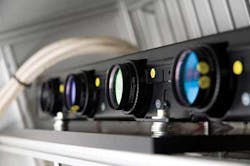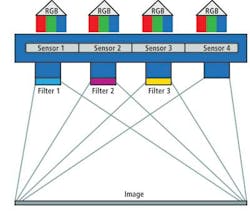Multispectral Camera System Speeds Print Inspection
Andrew Wilson, Editor
Printing companies strive to represent printed material as exact reproductions of what their customers desire. Although these companies understand the nature and properties of digital-to-print technologies and the inks used to reproduce color, there is still a need to check the output of each press for faithful color reproduction.
In the past, printers have turned to spectrophotometers to gauge the accuracy of printing processes and check the fidelity of color proofs. The instruments are extremely accurate; however, they can only be used in an off-line manner.
Individual samples must be analyzed using spectrophotometers during the printing process. After a number of print runs, colors are liable to change because of changes in the color formulation, the amount of ink deposited at any particular time, and the physical attributes of the printing press. Thus, even though an initial print run may meet expected standards, a longer print run may cause colors to be reproduced inexactly.
Color fidelity
Printer manufacturers must employ systems that continually monitor the color fidelity of the printed data so that, should any color imperfections occur, the printing process can be dynamically adjusted. Systems can use in-line RGB area-array and linescan cameras for this purpose; however, colors with different spectral coordinates can have the same RGB values, making it impossible to determine the true spectral nature of the reproduced color.
To overcome these problems, Chromasens has engineered a 12-channel spectral linescan camera system that can analyze color differences barely discernible by the human eye (see Fig. 1)—just like a spectrophotometer. Developed by Markus Schnitzlein, president of Chromasens, and researchers at the Constance University of Applied Sciences and the Chemnitz University of Technology, the system uses a novel combination of optics, linescan cameras, and software (see Fig. 2).
The system employs four trilinear 7k × 3-pixel linescan cameras to scan a field of view of 700 mm at a distance of 1.5 m. Because each of the 7k linescan cameras uses imagers with 10-μm pixels, the maximum attainable resolution at the field of view is 100 μm/pixel.
“To emulate the functionality of a spectrophotometer,” says Schnitzlein, “it is necessary to sample the frequency of each color at a narrow bandwidth.” In a spectrophotometer, for example, multiple samples may be taken at very narrow 5–10-μm bands across the 380–730-nm visible spectrum. By taking multiple images at multiple wavelengths, captured image data can then be used to determine the absolute color measurement at each point in the image.
Using a similar principle, the Chromasens 12-channel spectral linescan camera uses multiple bandpass filters, each of which filters light in three distinct bandwidths. “For example,” says Schnitzlein, “while one camera is used to filter light at wavelength peaks of 450, 550, and 650 nm across a 50-nm spectral band, the other two filter light at other parts of the visible spectrum, and the fourth camera allows the full RGB spectrum to be captured. So ultimately, nine approximately 50-nm-bandwidth channels are captured across the color spectrum.
Digitizing images
Although spectrophotometers may require very narrow 10-μm filters to perform color analysis, this is not required in the printing industry because reflected colors from printing inks exhibit smooth spectral shapes. Thus, the bandwidth of the filters can be larger. To digitize the images from the linescan spectral camera, the outputs from each of the four Camera Link Base cameras are interfaced to two PicPort-X-CL PCI-Express Camera Link frame grabbers from Leutron Vision.
In the host PC, areas of 10 × 10-pixel values from each of the 12 channels are averaged to provide a more accurate measurement of the color at any particular point. This process results in 12 smooth data channels, each of which provides a partial representation of the true spectral value of the image; these will be influenced by the spectral response of the RGB imager as well as the spectral response of the filters.
Because there is some spectral overlap between the filters used, each of the 12 channels will not be unique. However, all 12 channels can be used to determine the true color of the sample using an iterative technique known as projection onto convex sets (POCS).
To obtain an accurate result, the 12 channels of data must be combined into a single waveform that represents the scanned color. A simple combination of waveforms is not effective because only 12 different frequency bands are scanned.
Instead, the waveforms are first defined as convex sets within the visible frequency range. Any frequencies outside the convex set (such as those frequencies that require interpolation) are iteratively mapped onto the convex set to determine the correct intensity value. Since this process is iterative, as more iterations are computed, the color value returned will be more accurate.
Color reference
The reference color from section E2 of the Color Checker target is compared with both the initial color estimation and the computed value after 290 iterations (see Fig. 3). As can be seen, the reflectivity (or remission) given in arbitrary units most closely compares with the reference value. The estimated color function can be compared with the results of photometric measurements by mapping the function to CIE L*a*b space using a simple matrix transformation.
“According to the DIN 5033-1 standard,” says Schnitzlein, “the extent of color difference (in terms of sensitivity) between two colors—or their color difference is specified as a Delta E value. This is a linear scale where a Delta E between 0–1 represents practically no difference. For a Delta E between 1–3 the color difference is barely discernible by the trained eye and a Delta E 3–5 represents a major color difference.
“Using the 12 channel spectral linescan camera,” he continues, “we have shown that an average Delta E of 1.2 is achievable, which is acceptable for use in the printing industry.” To allow the spectral scanner to be used in high-speed web and sheet-fed printing applications, Chromasens has developed different versions of the scanner.
“Using 7k × 3 RGB linescan cameras allows the system to image paper at rates up to 6 m/s,” he says. At present, the system is in test at a number of large German printing companies to monitor the color fidelity of their printing processes in real time.
Company Info
Chemnitz University of Technology
Chemnitz, Germany
Konstanz University of Applied Sciences
Konstanz, Germany
Leutron Vision
Glattbrugg, Switzerland
Vision Systems Articles Archives



